 Opinion Article
Opinion Article
How Household Appliances Affect the Climate
Oleg Khalidullin, Academician of the Kazakh National University, Kazakhstan
Received Date: October 18, 2022; Published Date: November 23, 2022
Opinion
The intensity of energy passions in Europe, especially in connection with the war of Russia against Ukraine, and throughout the world, for example, regarding the construction of a nuclear power plant near Almaty in Kazakhstan, forces us to take part in the development of technical solutions to this problem. First of all, you need to find out: how is electricity used in everyday life, are such volumes needed, to see how, how much and what it is spent on? What consumes the most in every home.
According to https://poznayka.org/s80221t1.html: Refrigerators and freezers are among the most significant “consumers” of electricity in an apartment. They account for approximately 40% of all electricity in our apartments.”
The average power consumption of a refrigerator ranges from 100 to 200 W / h (at rest), the maximum is 300 W / h (when the compressor is running), that is, an average of about 250 W. The refrigerator consumes 0.25 x 24 - 6 kWh per day per day. Per year: 6 x 365 = 2190 kWh. In monetary terms: 2190 x 20.78 = 45508 tenge. This is how much one refrigerator consumes per year. It has been determined that there are 526462 apartments in the 2-million city of Almaty, Kazakhstan. We assume that each of them has at least one refrigerator.
Then 2190 x 526462 = 1152951780 kWh of energy consumed by domestic refrigerators alone per year. The nearest hydroelectric power plant generates 972,000,000 kW per year. Slightly less. An entire power plant works only to cool the products of one city. Winter and summer.
Is it possible to reduce electricity? Can somehow use the natural cold?
Let’s consider this idea in application to the southern regions of Kazakhstan, for example, Almaty. According to https://vik.by/ instruments/climatology/kazkhstan/city?name=almaty:
Average monthly values of air temperature and partial pressure of water vapor in Almaty
Month Temperature, °C
I January -6.5
II February -5.1
III March 2
IV April 10.8
V May 16.2
VI June 20.7
VII July 23.5
VIII August 22.3
IX September 17
X October 9.5
XI November 0.9
XII December -4.5
Average annual air temperature in Almaty, °С 8.9
From November to March - 5 months a year, the outside air temperature is in the range from +2 to -6.5 °C. In addition, in October and April at night the temperature drops to +2°C and lower, therefore, we can assume that in Almaty for half a year the outside air temperature is in the range required inside the refrigerator chamber - from +2 to +10°C.
The refrigerator consumes electricity to produce artificial cold, and outside the kitchen wall - natural cold outside. The study of existing refrigeration equipment shows that the constant and continuous year-round cooling of products in the refrigerator with artificial cold is a thoughtless waste, absurdity. The industry of production of various refrigerators and coolers is interested in their products and does not pay attention to economy and ecology.
Cooling of food in the refrigerator chambers is carried out by circulating a special refrigerant by a compressor through a closed circuit from the evaporator inside the chamber to the condenser - behind the refrigerator wall - into the kitchen room, and back. In this case, cold is formed inside the main volume of the chamber with products. In the winter and cold seasons of the year and day, energy is spent on the production of artificial cold.
The scheme of the most common typical device for operating refrigerators is taken from https://remont-holodilnika.spb.ru/kakustroen- holodilnik: (Figure 1).
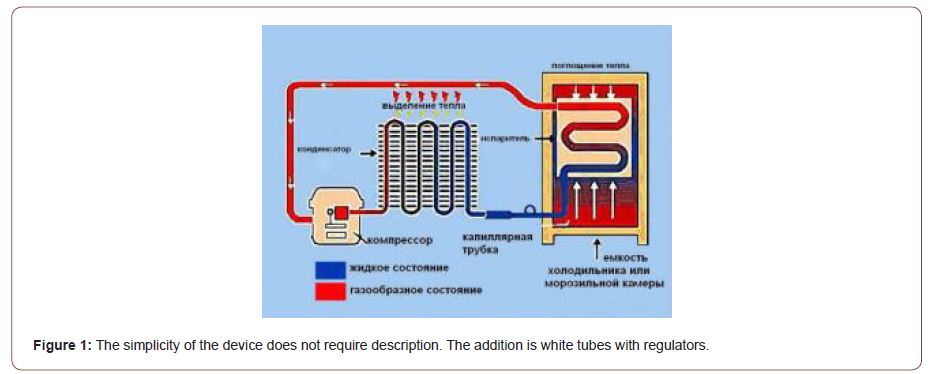
There is such an interesting, absurd paradox: in winter, artificial cold is created in the refrigerator chamber installed in the kitchen, and behind the wall, half a meter - outside - the air is cooled by nature itself.
It is enough to connect these two media through additional tubes - air ducts. One for air intake, the other for exhaust. These air ducts must be equipped with temperature-sensitive regulators - thermostats to change the air flow depending on the outside temperature. The colder it is outside, the less flow. The warmer, the more flow. When this boundary temperature outside is exceeded from +2 to +4°С, the thermostat completely closes the circulation, and the refrigerator automatically switches to normal mode. Thus, food can be cooled with free outdoor cold when it is colder outside (Figure 2).
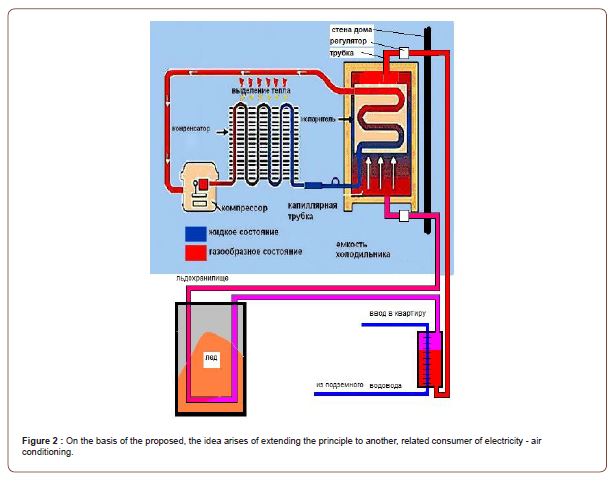
The simplicity of the device does not require description. The addition is white tubes with regulators. There is no air movement in the existing refrigerator, it stagnates and becomes moistened, forming icing, odors, and mold. Periodically it is necessary to defrost the cooling surfaces, which creates unnecessary labor and energy costs. An essential advantage of the new addition is the ventilation of the chamber space. Continuous air movement eliminates stagnation and all associated consequences and costs.
According to information from https://stot64.ru/sravneniyasmartfonov/ skolko-moshhnosti-potreblyaet-holodilnikv- srednem.html: A temperature of +4 to +6°C is generally recommended. Thus, the products are cooled by external natural cold for about six months. The compressor of the refrigerator at such a time does not turn on at all and does not consume electricity. Cold days and nights for the middle bands of the planet are more than half of the entire season, depending on the proximity to the poles of the planet. In accordance with this, power consumption is reduced by at least 2 times. And if we add industrial and commercial refrigerators to this, then on a city scale, the reduction in consumption can be reduced, maybe even by the same amount.
Developing the idea further, you can think and look for something that can be colder or correspond to the temperature inside the chamber space in the summer.
This is the cold-water supply. The temperature of the water at the inlet riser is equal to the temperature of the underground channel in which the conduit lies. And this temperature approximately corresponds to the required cold in the refrigerator - from +4 to +6°C. It remains only to install the radiator, let all the water consumed through it, and let the air passed through the outer surfaces of the radiator grill into the refrigerator air duct. The temperature of this water is stable and such a source of cold can be used all summer. It is quite possible that this temperature will suit the storage of products, then there is no need for artificial cold at all. Just for freezing. You can install a radiator in the refrigerator itself, then air ducts and fans are not needed, but the same air stagnation is formed.
You can also remember the time when there were no refrigerators at all, and many acquired cellars with frozen ice. If this method is modernized, then almost no electricity will be needed for cooling. For this, a volumetric sealed tank is arranged - a hollow cylinder, partially or completely underground, a meter, two meters in diameter and a height of 5 - 10 meters. The walls of the column are made of heat-insulating material. In winter, an automatic ice maker is installed, which produces ice at ambient temperature and is stored in this container. For example - patent 1 808 076 “Method of freezing structures from ice and a device for its implementation. In spring and summer, through special air ducts previously left in containers, the air taken from the underground water radiator is cooled by this ice and fed to refrigerators. In this way, it is possible to reduce the effect compressor to zero (Figure 3).
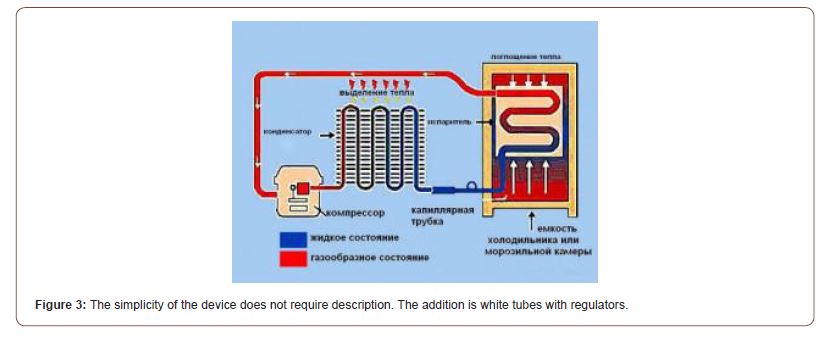
With the normal implementation of such a scheme, there is generally no need for a compressor and all cooling equipment. There is only one case with a door left. Of course, we will have to invest in the reconstruction of the underground water supply and the creation of an ice storage. But the subsequent savings in the form of a billion kilowatts for the city is quite a significant gain from an economic and environmental point of view (Figure 4).
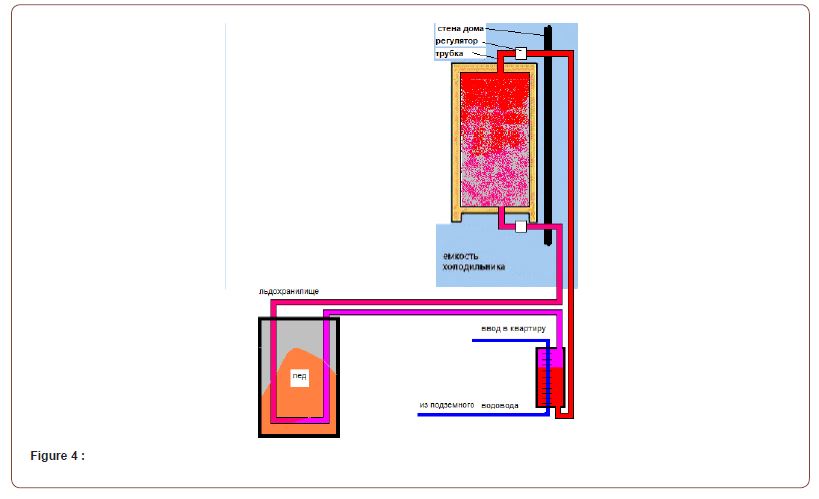
The development and creation of such an industry as the manufacture of household air conditioners, their sale, installation, maintenance is a necessity for countries close to the equator. In other areas, the number of hot days decreases with distance from the equator. But there are many people who allow themselves the installation of air conditioners so that 20, even 5 - 10, hot days a year are in comfort. Installation of air conditioners is not only their cost, maintenance, but also energy consumption.
Here you can also pay attention to the same cold-water pipeline. Water is supplied to the house, any housing from an underground conduit. Its temperature is stable at any time of the year and is within +4 - +60С. It is known that on average one person in a city apartment consumes 250 liters of water per day. It is rare that anyone uses water with such a temperature - it is almost always mixed with hot water. Even in hot weather. Do not mix it with hot water - this is an additional energy saving.
It is proposed to cool the air in the room with water from the water supply. This can be implemented in several ways. The first is to simply connect the water conduit to the radiators. And the output is to continue for consumption. The water will heat up a little, and the air in the room will cool down a little, maybe to the required comfortable 18 -220C, but much lower than outside the house 22 - 300C. Thus, you can create a favorable temperature in the apartment with a simple plumbing technique. It is not difficult to develop an automatic device for connecting a heating system to a cold-water pipeline when the room temperature exceeds a predetermined temperature, for example, 250С.The second way is to install a special radiator at the inlet of the water conduit and cool the air with this water, which is driven by a fan through the ventilation ducts throughout the apartment. The effect is also enhanced if air cooled by ice storage is used.
Then the whole branch of development, manufacture and sale of air conditioners for the middle geographical strip of the entire planet disappears. And the electricity consumption disappears energy. If all refrigerators in one city are modernized, then the nearest Kapchagai hydroelectric power station will be liquidated. Stop and dismantle all devices, release water, restore everything ruined during its construction. And the huge area of the water mirror - 1847 km², to return to nature, on each hectare of which 20 tons of underground living creatures will settle and natural evaporation will return - the basis of the climate - And if all this is done on the scale of the Almaty region, and even to eliminate all air conditioners, then there is no need to build a nuclear power plant.
There are many such cities around the world. Implementation everywhere could significantly affect the climate.
The intensity of energy passions in Europe, especially in connection with the war of Russia against Ukraine, and throughout the world, for example, regarding the construction of a nuclear power plant near Almaty in Kazakhstan, forces us to take part in the development of technical solutions to this problem. First of all, you need to know how electricity is used in everyday life, are such volumes needed, to see how, how much and what it is spent on? What consumes the most in every home. According to Refrigerators and freezers are among the most significant “consumers” of electricity in an apartment. They account for approximately 40% of all electricity in our apartments.”
The average power consumption of a refrigerator ranges from 100 to 200 W / h (at rest), the maximum is 300 W / h (when the compressor is running), that is, an average of about 250 W. The refrigerator consumes 0.25 x 24 - 6 kWh per day per day. Per year: 6 x 365 = 2190 kWh. In monetary terms: 2190 x 20.78 = 45508 tenge. This is how much one refrigerator consumes per year. It was determined that there are 526462 apartments in the 2-million city of Almaty, Kazakhstan. We assume that each of them has at least one refrigerator.
Then 2190 x 526462 = 1152951780 kWh of energy consumed by domestic refrigerators alone per year. The nearest hydroelectric power plant generates 972,000,000 kW per year. Slightly less. An entire power plant works only to cool the products of one city. Winter and summer. Is it possible to reduce electricity? Can somehow use the natural cold?
Let’s consider this idea in application to the southern regions of Kazakhstan, for example, Almaty.
According to https://vik.by/instruments/climatology/ kazkhstan/city?name=almaty: Average monthly air temperatures in Almaty (Table 1).
Table 1:Average monthly air temperatures in Almaty.
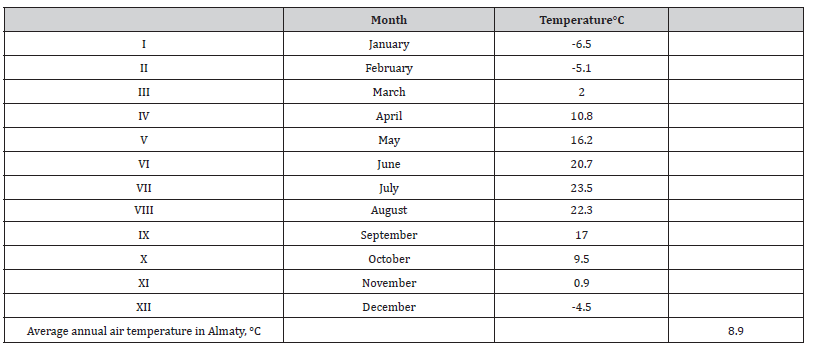
From November to March - 5 months a year, the outside air temperature is in the range from +2 to -6.5 °C. In addition, in October and April at night the temperature drops to +2°C and lower, therefore, we can assume that in Almaty for half a year the outside air temperature is in the range required inside the refrigerator chamber - from +2 to +10°C.
The refrigerator consumes electricity to produce artificial cold, and outside the kitchen wall - natural cold outside. The study of existing refrigeration equipment shows that the constant and continuous year-round cooling of products in the refrigerator with artificial cold is a thoughtless waste, absurdity. The industry of production of various refrigerators and coolers is interested in their products and does not pay attention to economy and ecology. The cooling of food in the refrigerator chambers is carried out by circulating a special refrigerant by a compressor through a closed circuit from the evaporator inside the chamber to the condenser - behind the refrigerator wall - to the kitchen room, and back. At the same time, cold is formed inside the main volume of the chamber with products. In the winter and cold season and day, energy is spent on the production of artificial cold. The scheme of the most common typical device for operating refrigerators is taken from https://remont-holodilnika.spb.ru/kak-ustroen-holodilnik: (Figure 4).
There is an interesting, absurd paradox: in winter, artificial cold is created in the refrigerator chamber installed in the kitchen, and behind the wall, half a meter - outside - the air is cooled by nature itself. It is enough to connect these two media through additional tubes - air ducts. One for air intake, the other for exhaust. These air ducts must be equipped with temperature-sensitive regulators - thermostats to change the air flow depending on the outside temperature. The colder it is outside, the less flow. The warmer, the more flow. When this limit temperature outside is exceeded from +2 to +4°C, the thermostat completely closes the circulation, and the refrigerator automatically switches to normal mode. Thus, food can be cooled with free outdoor cold when it is colder outside (Figure 5).
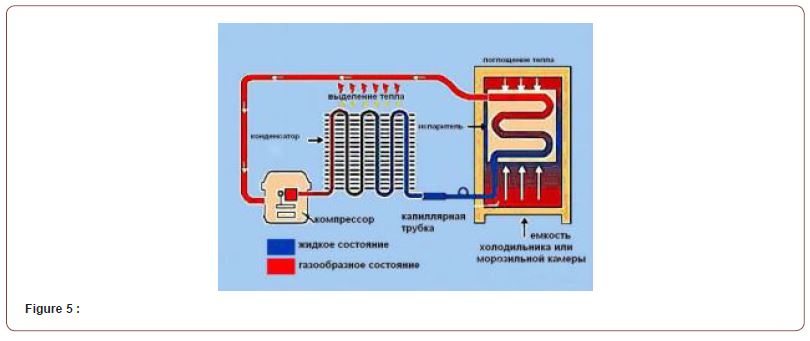
The simplicity of the device does not require description. The addition is white tubes with regulators.
There is no air movement in the existing refrigerator, it stagnates and becomes moistened, forming icing, odors, and mold. Cooling surfaces need to be defrosted periodically, which creates unnecessary labor and energy costs. An essential advantage of the new addition is the ventilation of the chamber space. Continuous air movement eliminates stagnation and all associated consequences and costs.
According to information from https://stot64.ru/sravneniyasmartfonov/ skolko-moshhnosti-potreblyaet-holodilnik-vsrednem. html: a temperature of +4 to +6°C is usually recommended. Thus, the products are cooled by external natural cold for about six months. The compressor of the refrigerator at such a time does not turn on at all and does not consume electricity. Cold days and nights for the middle bands of the planet are more than half of the entire season, depending on the proximity to the poles of the planet. In accordance with this, power consumption is reduced by at least 2 times. And if we add to this also industrial and commercial refrigerators, then on a city scale, the reduction in consumption can be reduced, maybe even by the same amount. Developing the idea further, you can think and look for something that can be colder or correspond to the temperature inside the chamber space in the summer.
This is the cold-water supply. The temperature of the water at the inlet riser is equal to the temperature of the underground channel in which the conduit lies. And this temperature approximately corresponds to the required cold in the refrigerator - from +4 to +6°C. It remains only to install the radiator, let all the water consumed through it, and let the air passed through the outer surfaces of the radiator grille into the refrigerator air duct. The temperature of this water is stable and all summer you can use such a source of cold. It is quite possible that this temperature will suit the storage of products, then there is no need for artificial cold at all. Just for freezing. You can install a radiator in the refrigerator itself, then air ducts and fans are not needed, but the same air stagnation is formed.
You can also remember the time when there were no refrigerators at all, and many acquired cellars with frozen ice. If this method is modernized, then almost no electricity will be needed for cooling. To do this, a volumetric sealed tank is arranged - a hollow cylinder, partially or completely underground, a meter, two meters in diameter and a height of 5 - 10 meters. The walls of the column are made of thermal insulation material. In winter, an automatic ice maker is installed, which produces ice at ambient temperature and is stored in this container. For example - patent 1 808 076 “Method of freezing structures from ice and a device for its implementation. In spring and summer, through special air ducts previously left in containers, the air taken from the underground water radiator is cooled by this ice and supplied to refrigerators. In this way, it is possible to reduce the effect compressor to zero (Figure 6).
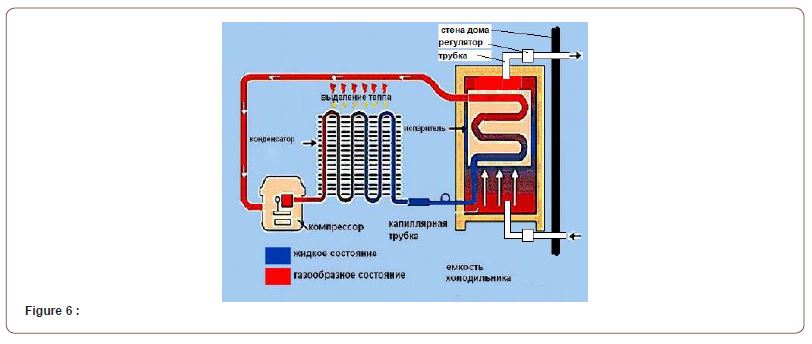
With the normal implementation of such a scheme, there is generally no need for a compressor and all cooling equipment. There is only one case with a door left. Of course, we will have to invest in the reconstruction of the underground water conduit and the creation of an ice storage. But the subsequent savings in the form of a billion kilowatts for the city is quite a significant gain from an economic and environmental point of view.
The development and creation of such an industry as the manufacture of household air conditioners, their sale, installation, maintenance is a necessity for countries close to the equator. In other areas, the number of hot days decreases with distance from the equator. But there are many people who allow themselves the installation of air conditioners so that 20, even 5 - 10, hot days a year are in comfort. Installation of air conditioners is not only their cost, maintenance, but also energy consumption. Here you can also pay attention to the same cold-water pipeline. Water is supplied to the house, any housing from an underground conduit. Its temperature is stable at any time of the year and is within +4 - +60C.
It is proposed to cool the air in the room with water from the water supply. This can be implemented in several ways. The first is to simply connect the water conduit to the radiators. And the output is to continue for consumption. The water will heat up a little, and the air in the room will cool down a little, maybe to the required comfortable 18 - 220 C, but much lower than outside the house 22 - 300 C. Thus, you can create a favorable temperature in the apartment with a simple plumbing technique. It is not difficult to develop an automatic device for connecting a heating system to a cold-water pipeline when the room temperature exceeds a predetermined temperature, for example, 250C.
The second way is to install a special radiator at the inlet of the water conduit and cool the air with this water, which is driven by a fan through the ventilation ducts throughout the apartment. The effect is also enhanced if air cooled by the ice storage is used. Then the whole branch of development, manufacture and sale of air conditioners for the middle geographic zone of the entire planet disappears. And the power consumption disappears.
If all refrigerators in one city are modernized, then the nearest Kapchagay hydroelectric power station will be liquidated. Stop and dismantle all devices, release water, restore everything ruined during its construction. And the huge area of the water mirror - 1847 km², to return to nature, on each hectare of which 20 tons of underground living creatures will settle and natural evaporation will return - the basis of the climate-And if all this is done on the scale of the Almaty region, and even to eliminate all air conditioners, then there is no need to build a nuclear power plant. There are many such cities around the world. Implementation everywhere could have a significant impact on the climate.
Acknowledgement
None
Conflict of Interest
No conflict of Interest
-
Oleg Khalidullin*. How Household Appliances Affect the Climate. Ad Oceanogr & Marine Biol. 3(2): 2022. AOMB. MS.ID.000559.
-
Climate, Nuclear power, Refrigerator, Temperature
-

This work is licensed under a Creative Commons Attribution-NonCommercial 4.0 International License.






